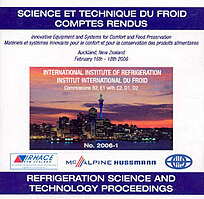
IIR document
Alternative models to predict the thermal conductivity of frozen foods.
Author(s) : WANG J. F., CARSON J. K., NORTH M. F., et al.
Summary
For two component materials, combinations of 5 fundamental effective thermal conductivity structural models (series, parallel, two forms of Maxwell-Eucken, effective medium theory) were wed to define 26 new models, each with a distinct and unique structure. The predictions of these models were compared to measured values for 22 high-moisture-content foods between -40 and -1°C. Near the initial freezing temperature, the accuracy of the models was constrained by the precision of the ice fraction model wed. Overall, the most accurate model was a combination of the parallel, Maxwell-Eucken (with ice as the dispersed phase) and series structures. However, other combined models were only slightly less accurate, and were superior to the Levy model which has previously been recommended for such foods. The final assessment of the best models for frozen foods will require information on ice fraction and structural features in addition to accurate measured thermal conductivity data.
Available documents
Format PDF
Pages: 2006-1
Available
Public price
20 €
Member price*
Free
* Best rate depending on membership category (see the detailed benefits of individual and corporate memberships).
Details
- Original title: Alternative models to predict the thermal conductivity of frozen foods.
- Record ID : 2007-0707
- Languages: English
- Source: Innovative Equipment and Systems for Comfort and Food Preservation.
- Publication date: 2006/02/16
Links
- See translations: La conductividad térmica en alimentos congelados: modelos alternativos para su predicción.
See other articles from the proceedings (51)
See the conference proceedings
Indexing
-
Themes:
Food engineering;
Freezing of foodstuffs - Keywords: Thermal conductivity; Food; Simulation; Frozen food; Modelling
-
Modelling thermal conductivity of frozen foods ...
- Author(s) : TARNAWSKI V. R., BOVESECCHI G., COPPA P., et al.
- Date : 2007/08/21
- Languages : English
- Source: ICR 2007. Refrigeration Creates the Future. Proceedings of the 22nd IIR International Congress of Refrigeration.
- Formats : PDF
View record
-
Predicting the thermal conductivity of low wate...
- Author(s) : CARSON J. K., WANG J. F., NORTH M. F., et al.
- Date : 2011/08/21
- Languages : English
- Source: Proceedings of the 23rd IIR International Congress of Refrigeration: Prague, Czech Republic, August 21-26, 2011. Overarching theme: Refrigeration for Sustainable Development.
- Formats : PDF
View record
-
ESTIMATION OF THERMOPHYSICAL PROPERTIES OF FOOD...
- Author(s) : SUCCAR J.
- Date : 1985
- Languages : English
View record
-
SIMULTANEOUS DETERMINATION OF THERMAL CONDUCTIV...
- Author(s) : DOMINGUEZ M., et al.
- Date : 1991/08/10
- Languages : English
- Source: New challenges in refrigeration. Proceedings of the XVIIIth International Congress of Refrigeration, August 10-17, 1991, Montreal, Quebec, Canada.
- Formats : PDF
View record
-
Thermal conductivity of controlled ice-fraction...
- Author(s) : CARSON J. K., WANG J. F., WILLIX J., et al.
- Date : 2007/08/21
- Languages : English
- Source: ICR 2007. Refrigeration Creates the Future. Proceedings of the 22nd IIR International Congress of Refrigeration.
- Formats : PDF
View record
